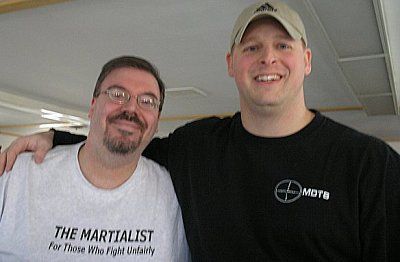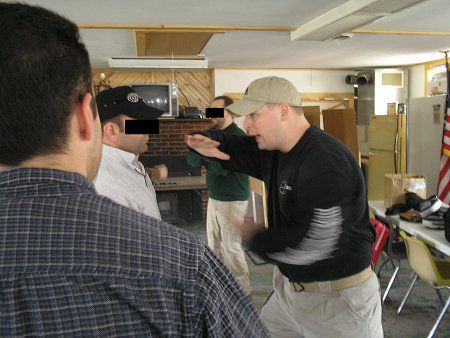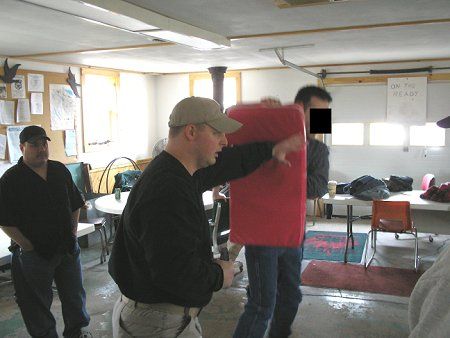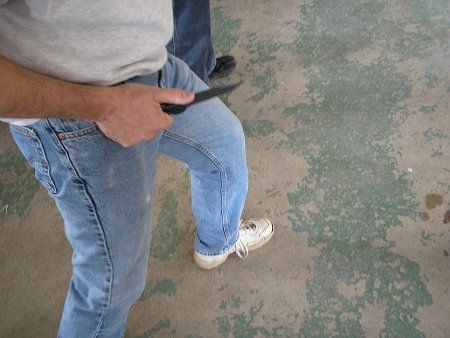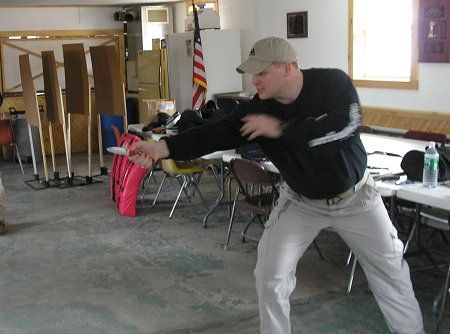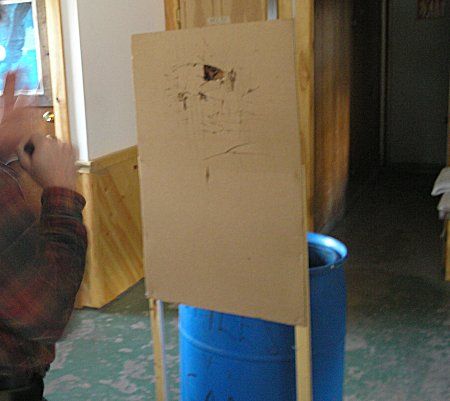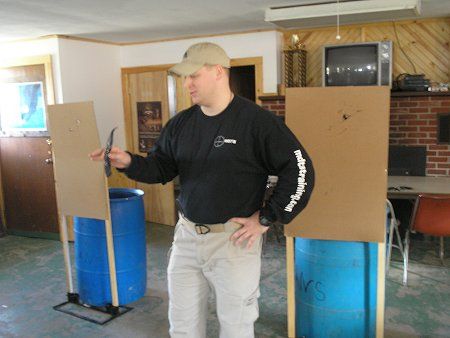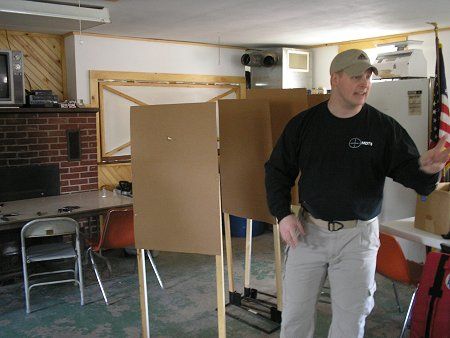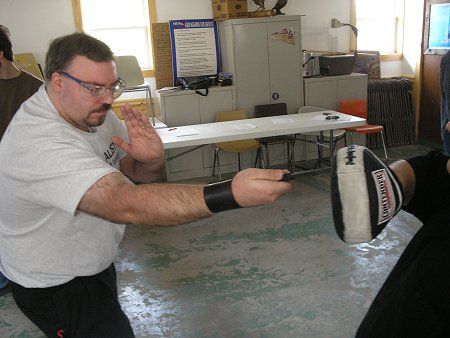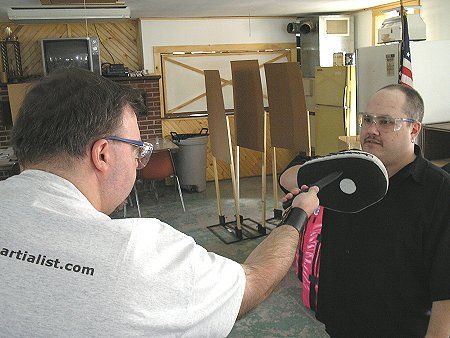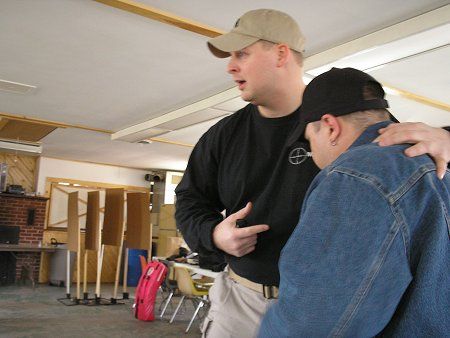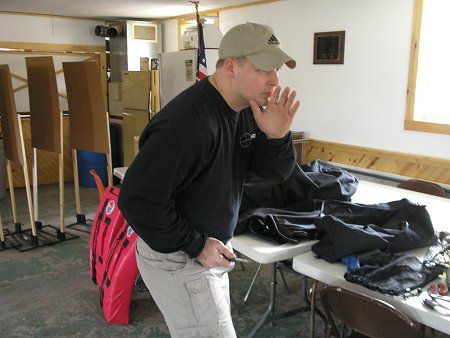Phil Elmore
Master of Arts
Today I had the pleasure of spending my Saturday in the company of Chris Fry of MDTS/Progressive FORCE Concepts and maybe 10 to 12 other students for a knife seminar on the carry, deployment, and defensive/offensive use of knives (primarily folders, though we covered some fixed blade aspects).
As usual, Chris ran a very easygoing but efficient class, demonstrating his natural teaching ability, his years of martial arts experience (which really comes out whenever he deals with blades and with empty hand work, but which is even evident during his firearms seminars), and his general competence when it comes to instructing a diverse group of people in how to do something that is both physical and mental.
He kept the class on track but allowed for useful tangents, kept the students focused, let them make mistakes just long enough so that he could point them out and correct them (always with an eye towards encouraging rather than discouraging), used humor but reminded us of the seriousness of knife work, and ran drills systematically, building on each one. This is classic good teaching, both in demeanor and in the "instructional design" aspect. Take a sloppy, poorly planned seminar and you'll immediately appreciate the difference between that and this.
This was a four hour class that ran a little longer than that, with a review of some previous empty hand MDTS/PFC combatives material (drop stepping into edge of hand blows, palm heels, forearm smashes, etc.). We first covered safety (Chris always stresses safety and emphasized the utility of eye protection in classes of this type) and then spent considerable time on the drawstroke with our folders (covering the differences and variations possible).
Folder deployment centered on first slapping the knife (levering aside any outer garments and keeping them back), shoving the web of the hand deeply onto the pocket-clipped folder, pulling the folder out of the pocket (using the index finger for leverage on the clip as necessary and applicable), bracing the folder aganist the hip, and thumbing it open. (Deviations in the mechanics for specific designs, such as the Wave and the the Carson Flipper, were also covered for those of us who had them.)
Chris instructed us in two no-surprises stances -- a defensive stance with the knife leg back, the folder braced against the hip, and the off hand up and protecting the face; and an offensive stance which was the same thing, but with the knife leg forward (the knife still held close to the body and braced against the hip). The utility of keeping the knife close to the body with the elbows down was also emphasized.
We ran through a series of drills that included targeting with pads, some entering and clearing, and some combinations, all using rubber knives and launching the four basic weapons Chris taught us systematically. The first weapon was the snap cut, which some of you might call a comma cut; it starts with the palm nominally up while the folder is braced against the hip and shoots out, the blade rotating, thrusting into the target with the palm facing down, then very quickly retracting back to the ready position, the whole movement a snap! of quick action.
The second attack was a vertical cut, in which the blade launches out vertically and slices down and through as the arm retracts (used for cutting down and clearing a horizontal obstacle like an arm held parallel to the ground in front of the body).
The third and fourth weapons were palm-up and palm-down horizontal cuts, which come out and trace a tight triangular pattern in the air as they cut horizontally across the target and then retract back to ready.
After the partner drills with rubber knives (including variations and counters) we did some cutting of cardboard sheets. "Chunking" attacks to the eyes left devastating wounds that looked like the eye cutouts of a jack-o-lantern.
The four weapons I described previously were practiced on the cardboard and this cutting medium really showed us if we were performing the techniques properly. While not a realistic medium like, say, meat, it nonetheless showed us when we were properly snap-cutting or slashing horizonatlly -- and when we were simply flailing the knife at the target o little or no effect. Those of you who don't do a lot of test cutting really should start; the feedback it provides is immensely helpful and I was reminded that I should do more of this type of thing than I have been doing.
At the end of the class we covered some draw fouls and other counters using blue guns -- with one partner attempting to draw a gun and the other partner stopping the draw or interfering and knifing the gunner (if he could).
Every time I take a class with Chris I cannot wait to sign up for another one. This is pragmatic training that covers essential basics and introduces some more advanced material -- training that will benefit complete beginners and experienced martial artists alike. This class specifically (or something like it) should be required curriculum for anyone who carries a folder or self-defense. It will teach you what your folder realistically can and cannot do, and under what conditions it can be expected to do it. It will also teach you if you, the wielder, aren't up to snuff and should be practicing more.
I'm off to hack away at my targets now.
As usual, Chris ran a very easygoing but efficient class, demonstrating his natural teaching ability, his years of martial arts experience (which really comes out whenever he deals with blades and with empty hand work, but which is even evident during his firearms seminars), and his general competence when it comes to instructing a diverse group of people in how to do something that is both physical and mental.
He kept the class on track but allowed for useful tangents, kept the students focused, let them make mistakes just long enough so that he could point them out and correct them (always with an eye towards encouraging rather than discouraging), used humor but reminded us of the seriousness of knife work, and ran drills systematically, building on each one. This is classic good teaching, both in demeanor and in the "instructional design" aspect. Take a sloppy, poorly planned seminar and you'll immediately appreciate the difference between that and this.
This was a four hour class that ran a little longer than that, with a review of some previous empty hand MDTS/PFC combatives material (drop stepping into edge of hand blows, palm heels, forearm smashes, etc.). We first covered safety (Chris always stresses safety and emphasized the utility of eye protection in classes of this type) and then spent considerable time on the drawstroke with our folders (covering the differences and variations possible).
Folder deployment centered on first slapping the knife (levering aside any outer garments and keeping them back), shoving the web of the hand deeply onto the pocket-clipped folder, pulling the folder out of the pocket (using the index finger for leverage on the clip as necessary and applicable), bracing the folder aganist the hip, and thumbing it open. (Deviations in the mechanics for specific designs, such as the Wave and the the Carson Flipper, were also covered for those of us who had them.)
Chris instructed us in two no-surprises stances -- a defensive stance with the knife leg back, the folder braced against the hip, and the off hand up and protecting the face; and an offensive stance which was the same thing, but with the knife leg forward (the knife still held close to the body and braced against the hip). The utility of keeping the knife close to the body with the elbows down was also emphasized.
We ran through a series of drills that included targeting with pads, some entering and clearing, and some combinations, all using rubber knives and launching the four basic weapons Chris taught us systematically. The first weapon was the snap cut, which some of you might call a comma cut; it starts with the palm nominally up while the folder is braced against the hip and shoots out, the blade rotating, thrusting into the target with the palm facing down, then very quickly retracting back to the ready position, the whole movement a snap! of quick action.
The second attack was a vertical cut, in which the blade launches out vertically and slices down and through as the arm retracts (used for cutting down and clearing a horizontal obstacle like an arm held parallel to the ground in front of the body).
The third and fourth weapons were palm-up and palm-down horizontal cuts, which come out and trace a tight triangular pattern in the air as they cut horizontally across the target and then retract back to ready.
After the partner drills with rubber knives (including variations and counters) we did some cutting of cardboard sheets. "Chunking" attacks to the eyes left devastating wounds that looked like the eye cutouts of a jack-o-lantern.
The four weapons I described previously were practiced on the cardboard and this cutting medium really showed us if we were performing the techniques properly. While not a realistic medium like, say, meat, it nonetheless showed us when we were properly snap-cutting or slashing horizonatlly -- and when we were simply flailing the knife at the target o little or no effect. Those of you who don't do a lot of test cutting really should start; the feedback it provides is immensely helpful and I was reminded that I should do more of this type of thing than I have been doing.
At the end of the class we covered some draw fouls and other counters using blue guns -- with one partner attempting to draw a gun and the other partner stopping the draw or interfering and knifing the gunner (if he could).
Every time I take a class with Chris I cannot wait to sign up for another one. This is pragmatic training that covers essential basics and introduces some more advanced material -- training that will benefit complete beginners and experienced martial artists alike. This class specifically (or something like it) should be required curriculum for anyone who carries a folder or self-defense. It will teach you what your folder realistically can and cannot do, and under what conditions it can be expected to do it. It will also teach you if you, the wielder, aren't up to snuff and should be practicing more.
I'm off to hack away at my targets now.

